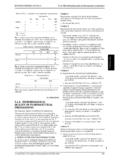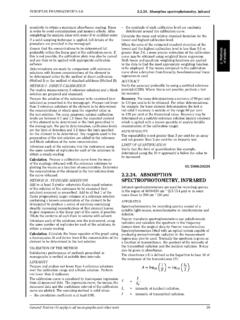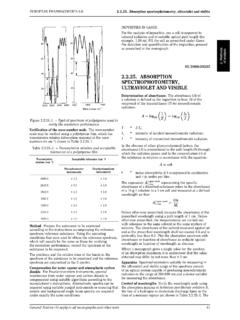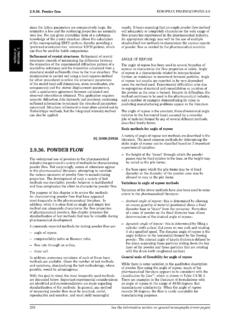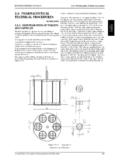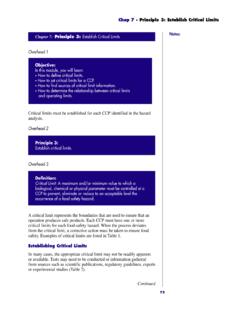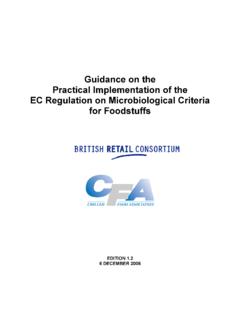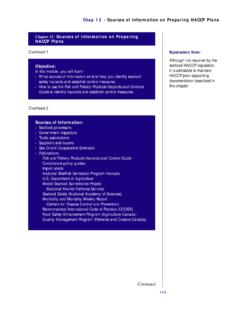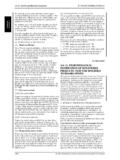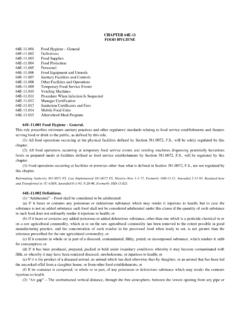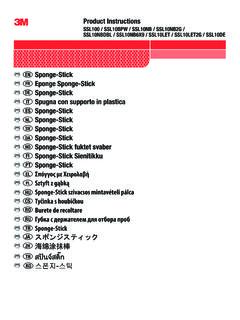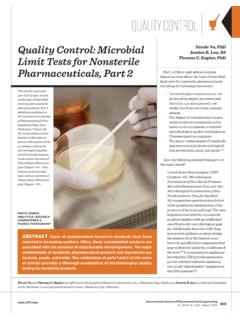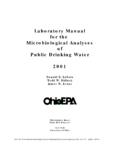Transcription of 2.6.13. MICROBIOLOGICAL EXAMINATION OF NON-STERILE
1 EUROPEAN PHARMACOPOEIA Test for specified micro-organisms 5-2-2-2. Surface-spread method. sub-lethally injured organisms are relevant for the quality of Prepare the sample using a method that has been shown the product, a resuscitation must be included in EXAMINATION to be suitable as described in section 4. Prepare at least 2 procedures that rely on selective media. Petri dishes for each medium and each level of dilution. For If the product to be examined has antimicrobial activity, this incubation and calculation of the number of CFU proceed as must be adequately neutralised. described for the pour-plate method. Enterobacteria and certain other gram-negative bacteria 5-2-3. Most-probable-number method Although the test has been designed to detect bacteria Prepare and dilute the sample using a method that has been belonging to the family of Enterobacteriaceae, it is shown to be suitable as described in section 4.
2 Incubate all recognised that other types of organisms ( Aeromonas, tubes at 30-35 C for 3-5 days. Subculture if necessary, using Pseudomonas) may be recovered. the procedure shown to be suitable. Record for each level of dilution the number of tubes showing microbial growth. Detection of bacteria. Prepare the product to be examined Determine the most probable number of micro-organisms as described in the general method , but using broth per gram or millilitre of the product to be examined from medium D in place of buffered sodium chloride-peptone Table solution pH , homogenise and incubate at 35-37 C for a time sufficient to revive the bacteria but not sufficient 5-3. INTERPRETATION OF THE RESULTS to encourage multiplication of the organisms (usually 2 h The total aerobic microbial count (TAMC) is considered to be but not more than 5 h).
3 Shake the container, transfer the equal to the number of CFU found using casein soya bean quantity of the contents (homogenate A) corresponding to digest agar ; if colonies of fungi are detected on this medium, 1 g or 1 ml of the product to 100 ml of enrichment medium E. they are counted as part of the TAMC. The total combined and incubate at 35-37 C for 18-48 h. Subculture on plates yeasts/mould count (TYMC) is considered to be equal to the of agar medium F. Incubate at 35-37 C for 18-24 h. The number of CFU found using Sabouraud-dextrose agar ; if product passes the test if there is no growth of colonies of colonies of bacteria are detected on this medium, they are gram-negative bacteria on any plate. counted as part of the TYMC. When the TYMC is expected to exceed the acceptance criterion due to the bacterial growth, Quantitative evaluation.
4 Inoculate suitable quantities of Sabouraud-dextrose agar containing antibiotics may be used. enrichment broth medium E with homogenate A and/or If the count is carried out by the MPN method the calculated dilutions of it containing respectively g, g and value is the TAMC. g (or ml, ml and ml) of the product to be examined. Incubate at 35-37 C for 24-48 h. Subculture When an acceptance criterion for MICROBIOLOGICAL quality is each of the cultures on a plate of agar medium F to obtain prescribed it is interpreted as follows: selective isolation. Incubate at 35-37 C for 18-24 h. Growth 101 CFU : maximum acceptable count = 20 ; of well-developed colonies, generally red or reddish, of 102 CFU : maximum acceptable count = 200 ; gram-negative bacteria constitutes a positive result. Note the smallest quantity of the product that gives a positive 103 CFU : maximum acceptable count = 2000, and so forth.
5 Result and the largest quantity that gives a negative result. The recommended solutions and media are described in Determine from Table the probable number of general chapter (under section B, Harmonised bacteria. method). Table Results for each quantity of product Probable number of bacteria per gram 01/2008:20613 g or g or g or of product ml ml ml corrected + + + More than 103. MICROBIOLOGICAL + + Less than 103 and more than 102. EXAMINATION OF NON-STERILE + Less than 102 and PRODUCTS : TEST FOR SPECIFIED . more than 10. Less than 10. MICRO-ORGANISMS. This general chapter presents 2 sets of tests. The 1st set gives When testing transdermal patches, filter 50 ml of the reference methods for determining compliance with preparation B as described in the general method monographs. Reference to this chapter in a monograph through a sterile filter membrane, place the membrane therefore implies compliance with the 1st set of tests, in 100 ml of enrichment broth medium E and incubate unless use of the 2nd set of tests has been authorised.
6 The at 35-37 C for 18-24 h. After incubation, spread on agar tests in the 2nd set also constitute official methods of the medium F for the detection of Enterobacteria and other European Pharmacopoeia and may be referred to as such, gram-negative micro-organisms. notably in applications for marketing authorisation. It Escherichia coli is intended to replace the 1st set by the 2nd set once the monographs concerned have been revised. The 2nd set Prepare the product to be examined as described in the presents tests developed in co-operation with the Japanese general method and use 10 ml or the quantity Pharmacopoeia and the United States Pharmacopeia to corresponding to 1 g or 1 ml to inoculate 100 ml of broth achieve harmonised requirements. medium A, homogenise and incubate at 35-37 C for 18-48 h. Shake the container, transfer 1 ml to 100 ml of broth A.
7 METHOD OF THE EUROPEAN PHARMACOPOEIA medium G and incubate at 43-45 C for 18-24 h. Subculture on plates of agar medium H at 35-37 C for 18-72 h. Growth In this general method the use of certain selective media of red, non-mucoid colonies of gram-negative rods indicates is proposed. A feature common to all selective media is the possible presence of E. coli. This is confirmed by that sub-lethally injured organisms are not detected. As suitable biochemical tests, such as indole production. The General Notices (1) apply to all monographs and other texts 173. Test for specified micro-organisms EUROPEAN PHARMACOPOEIA product passes the test if such colonies are not seen or if the Nutritive and selective properties of the media and validity confirmatory biochemical tests are negative. of the test Salmonella The tests described hereafter must be performed at least on Prepare the product to be examined as described in the each lot of dehydrated media.
8 General method , but using broth medium A in Proceed as follows. Grow the following test strains place of buffered sodium chloride-peptone solution pH , separately, in tubes containing suitable media such as those homogenise and incubate at 35-37 C for 18-24 h. Transfer indicated, at 30-35 C for 18-24 h : 1 ml of the enrichment culture to 10 ml of broth medium I Staphylococcus aureus such as ATCC 6538 (NCIMB 9518, CIP ) : and incubate at 41-43 C for 18-24 h. Subculture on at least broth medium A ;. 2 different agar media chosen from among agar medium J, Pseudomonas aeruginosa such as ATCC 9027 (NCIMB 8626, CIP ) : agar medium K and agar medium L. Incubate at 35-37 C for broth medium A ;. 18-72 h. The probable presence of salmonellae is indicated Escherichia coli such as ATCC 8739 (NCIMB 8545, CIP ) : broth medium A.
9 By the growth of cultures having the following appearance : Salmonella typhimurium no strain number is recommended (a agar medium J : well-developed, colourless colonies ; salmonella not pathogenic for man, such as Salmonella abony (NCTC 6017, CIP ), agar medium K : well-developed, red colonies, with or may also be used) : broth medium A. without black centres ;. Dilute portions of each of the cultures using buffered agar medium L : small, transparent, colourless or pink or sodium chloride-peptone solution pH to make test opaque-white colonies, often surrounded suspensions containing about 1000 viable micro-organisms by a pink or red zone. per millilitre. Mix equal volumes of each suspension and use Transfer separately a few of the suspect colonies to agar ml (approximately 100 micro-organisms of each strain). medium M in tubes, using surface and deep inoculation.
10 The as an inoculum in tests for S. aureus, P. aeruginosa, E. coli presence of salmonellae is provisionally confirmed if in the and Salmonella in the presence and in the absence of the deep inoculation but not in the surface culture there is a product to be examined. A positive result for the respective change of colour from red to yellow and usually a formation micro-organisms must be obtained. of gas, with or without production of hydrogen sulphide Clostridia in the agar. Precise confirmation may be carried out by The tests described below are intended for distinct purposes. appropriate biochemical and serological tests. The product The first method is intended for products where exclusion passes the test if colonies of the type described do not appear of pathogenic clostridia is essential and it is necessary to or if the confirmatory biochemical and serological tests are test for their absence.
